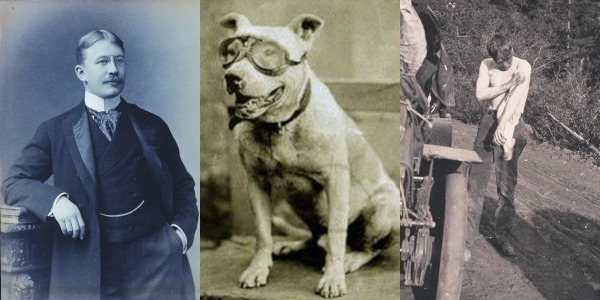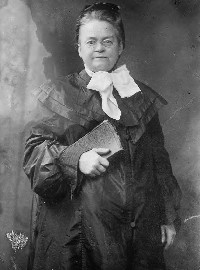Sponsor this page. Your banner or text ad can fill the space above.
Click here to Sponsor the page and how to reserve your ad.
-
Timeline
1903 - Detail
July 26, 1903 - The first cross-country automobile trip in the United States is completed with arrival in New York. The trip had begun in San Francisco on May 23.

What do a physician, a pit bull, and a bicycle racing car mechanic have in common? How about they are the three participants in the first cross country auto trip in 1903. Surprisingly it wasn't the dog who first came up with the idea, nor the bike racing car mechanic. Not surprisingly, it started with testosterone, that male ego enducing substance that forced Physician Horatio Nelson Jackson, a native of Vermont, on May 19, 1903, to argue, then take a $50 bet that he could take a car on a transcontinental trip from San Francisco to New York in less than ninety days. A train would only take three and one-half days at the time. But with car travel rather new, this was an audacious bet. Some say it was with his wife, Bertha Richardson Wells, who made the bet. Others say it was someone at the posh University Club in San Francisco where he had been a guest. Nobody had come close to completing the trip before. There were only one hundred and fifty miles of paved roads in the entire country.
Four days of frantic preparation led to a co-driver, Sewell K. Crocker, the bicycle racing car mechanic, who suggested they use a Winton touring car, one of the few cars made in the United States, to take the trip. The car was used, red, with two cylinders and twenty horsepower. They removed the back seat and loaded it with provisions; food, extra gas, sleeping bags, guns, a Kodak camera, and one spare tire.
The Winton was an American made car manufactured in Cleveland Ohio with B.F. Goodrich tires. Alexander Winton, a former bicycle maker, started the firm in 1897. He had sold his first cars in 1898, twenty-two in total, including one to James Ward Packard. Yes, he would start his own car company in 1899. That year, Winton sold over one hundred vehicles, including a semi-truck, making Winton the largest seller of gas powered vehicles in the nation. His first auto dealership opened in Reading, Pennsylvania, the cars taken there by the first automobile hauler. Famous people began to buy his cars; two to the Vanderbilts, which helped his publicity. Losing a race to Henry Ford in 1901 did not, but that did not stop Winton. He developed an engine and car, the Winton Bullet, in 1902 that topped out at seventy miles per hour. The Bullet lost to Ford again, but had gained more publicity. Thus, when Horatio Nelson Jackson needed a car for his journey, Sewell Crocker suggested the Winton. Maybe that was because he knew of the Winton's since their bike manufacturing days.

How The Trip Went
Beginning on Market Street in San Francisco, Jackson and Sewell began their journey on May 23, 1903; fifteen miles out they got their first flat, switching it for the only spare. Unlike other attempts, there had been two before them, the party headed north first to Oregon, before turning east. They were making an average of seventy-one miles per day across dirt roads and fields. By the time they hit Idaho, near Caldwell, a third companion would be added to the adventure. Pitbull Bud was bought for $15, outfitted with goggles, and took his seat between them. What Bud's job on the trip was, we're not sure, but Jackson had been discussing adding a dog since Sacramento. But with the visage of Bud in goggles, the purpose might have been comic relief. It would have been needed. Jackson lost his coat with all his money in it; he had to wire his wife for more. They got lost for thirty-six hours in Wyoming, June 20 and 21, without any food, before they stumbled upon a rancher who gave them a meal.
As they approached the prairie, the party had already overcome a broken clutch, more blown tires, a clogged oil line, and a shortage of gas (they once paid $1 per gallon for five gallons of gas), running out several times. They used a block and tackle to pull them from mud holes. The party relied on the stagecoach and train lines to bring them parts; blacksmiths were often hired to help with the repairs. By July 12, 1903, their journey had brought them to Omaha, Nebraska and made them celebrities, bringing crowds to see them in the towns they passed.
It also brought them to more developed areas and some paved roads, which pushed their miles per day up to one hundred and fifty or two hundred and fifty miles. There was a celebratory stop in Chicago, an accident (nobody hurt) in Buffalo, then finally, a jaunt down Fifth Avenue in New York City at 4:30 a.m. on July 26, 1903. At that early hour, there was nobody there to greet them.
The trek had crossed four thousand five hundred miles in sixty-three days, twelve hours, and thirty minutes, easily beating the ninety day window to win the bet. The $50 was never collected, and it had cost Jackson $8,000 to make the journey. He got to keep the dog. Bud lived a happy life in the Jackson's home in Burlington, Vermont.

Other Tidbits About the Adventure
Two other parties had taken the adventure while the Jackson party were en route, trying to overtake them and become the first to accomplish the task. They did not catch up.
The 1903 Winton touring car was nicknamed the Vermont by Jackson.
The original Winton car and Bud's goggles are now owned by the National Museum of American History, Behring Center, at the Smithsonian Institute.
The Winton Car Company used the accomplishment in many ads going forward, often with Bud on the cover of the advertisement.
After the excursion, co-driver Sewell K. Crocker attempted to get funding for a cross-world auto trip, but the trip never occurred.
Photo above: Jackson, Crocker, and dog Bud on their cross country road trip in 1903, 1903, unknown photographer. Courtesy Special Collections, University of Vermont. Photo below: Montage (left) Horatio Nelson Jackson, 1903; (center) Bud, the dog, 1903, Mary Louise Blanchert. Courtesy Wikipedia Commons; (right) Sewell fixing the car, 1903, unknown photographer. Others courtesy Special Collections, University of Vermont. Source info: "Crossing America by Car: A Bar Bet Led to a History-Making Journey in 1903," 2020, Barbara Toombs, Barrett-Jackson Media; "Historical Hounds: Bud the Pitbull Joined the First US Cross-Country Road Trip Ever in 1903," Mike Clark, dogtime.com; National Museum of American History; Wikipedia Commons.






